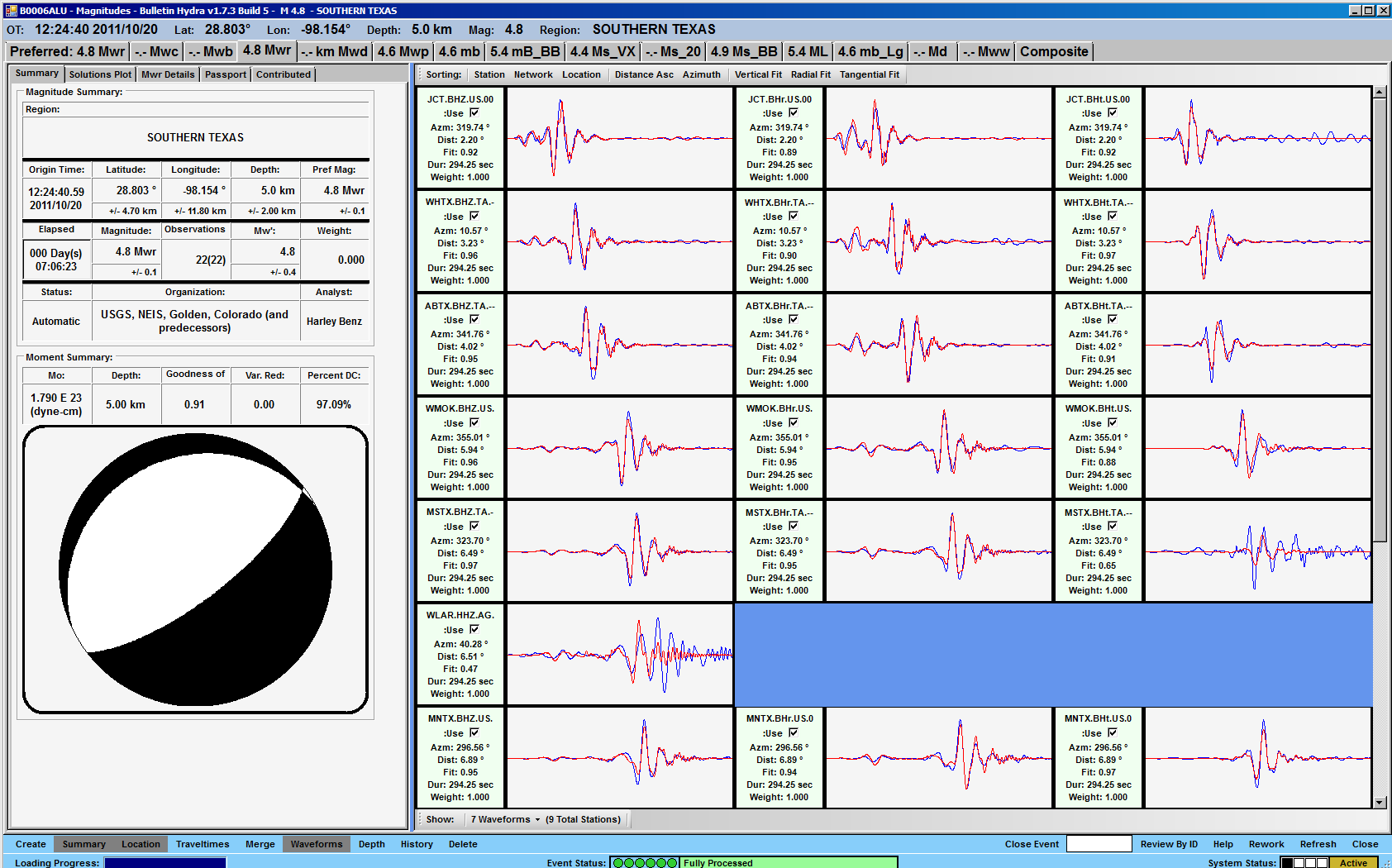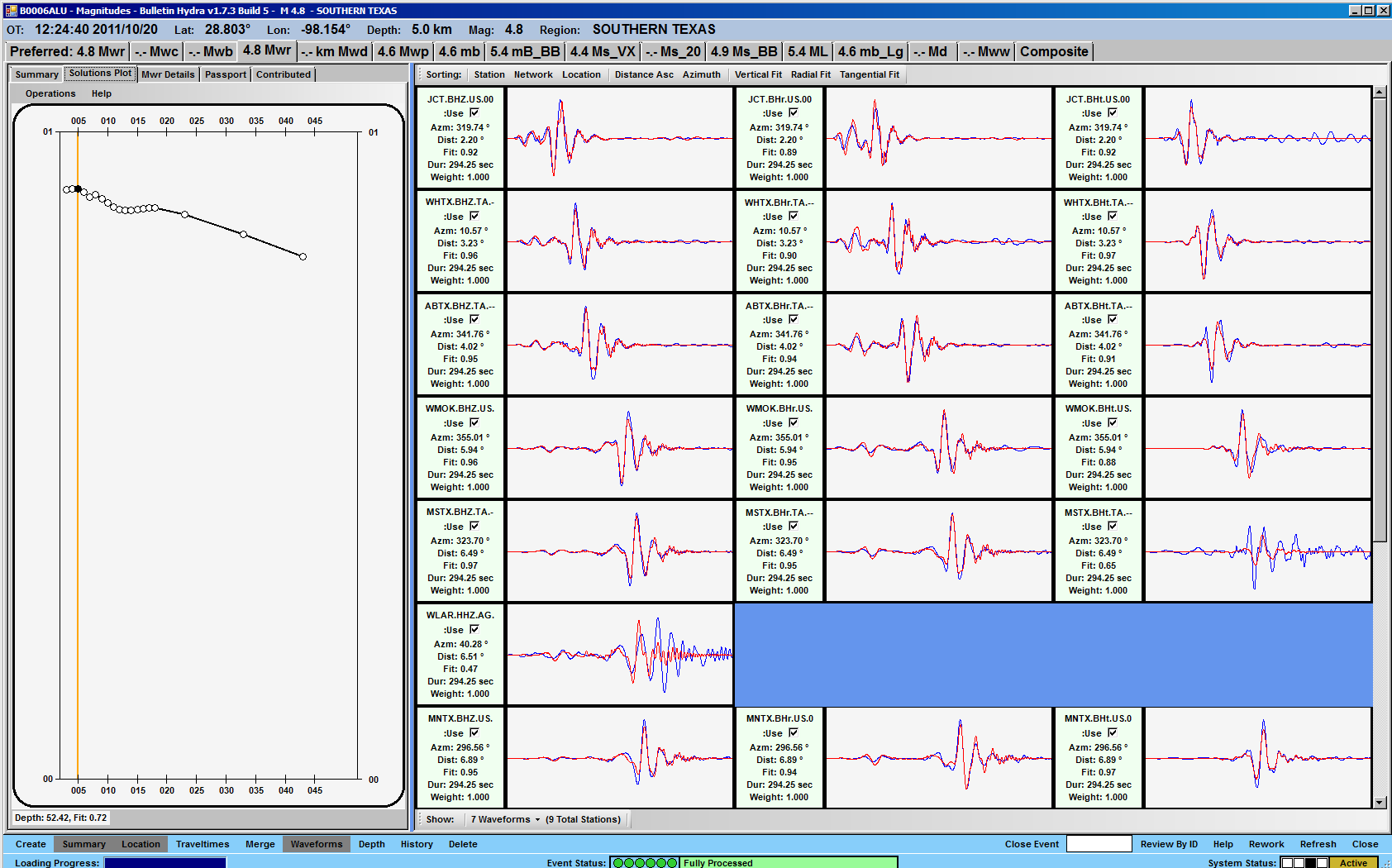Location
Location ANSS
The ANSS event ID is usp000j9kx and the event page is at
https://earthquake.usgs.gov/earthquakes/eventpage/usp000j9kx/executive.
2011/10/20 12:24:41 28.865 -98.079 5.0 4.8 Texas
Focal Mechanism
USGS/SLU Moment Tensor Solution
ENS 2011/10/20 12:24:41:0 28.86 -98.08 5.0 4.8 Texas
Stations used:
IU.ANMO MX.HPIG MX.LNIG NM.MGMO NM.SLM TA.136A TA.137A
TA.138A TA.139A TA.239A TA.336A TA.337A TA.ABTX TA.S34A
TA.S35A TA.S36A TA.S37A TA.S38A TA.S39A TA.S40A TA.S41A
TA.S45A TA.WHTX TA.X35A TA.X36A TA.Y35A TA.Y37A TA.Y38A
TA.Z37A TA.Z38A TA.Z39A US.AMTX US.CBKS US.ISCO US.JCT
US.KSU1 US.MIAR US.MVCO US.NATX US.OGNE US.SDCO US.WMOK
US.WUAZ
Filtering commands used:
hp c 0.02 n 3
lp c 0.04 n 3
Best Fitting Double Couple
Mo = 9.66e+22 dyne-cm
Mw = 4.59
Z = 3 km
Plane Strike Dip Rake
NP1 44 47 -105
NP2 245 45 -75
Principal Axes:
Axis Value Plunge Azimuth
T 9.66e+22 1 144
N 0.00e+00 11 54
P -9.66e+22 79 240
Moment Tensor: (dyne-cm)
Component Value
Mxx 6.31e+22
Mxy -4.71e+22
Mxz 7.47e+21
Myy 3.02e+22
Myz 1.60e+22
Mzz -9.33e+22
##############
######################
############################
##############################
#################------------###--
#############--------------------##-
###########-----------------------####
#########--------------------------#####
#######----------------------------#####
#######----------------------------#######
#####------------- -------------########
####-------------- P -------------########
###--------------- -----------##########
##----------------------------##########
#----------------------------###########
--------------------------############
-----------------------#############
-------------------###############
-------------#################
####################### ##
#################### T
##############
Global CMT Convention Moment Tensor:
R T P
-9.33e+22 7.47e+21 -1.60e+22
7.47e+21 6.31e+22 4.71e+22
-1.60e+22 4.71e+22 3.02e+22
Details of the solution is found at
http://www.eas.slu.edu/eqc/eqc_mt/MECH.NA/20111020122441/index.html
|
Preferred Solution
The preferred solution from an analysis of the surface-wave spectral amplitude radiation pattern, waveform inversion or first motion observations is
STK = 245
DIP = 45
RAKE = -75
MW = 4.59
HS = 3.0
The NDK file is 20111020122441.ndk
The waveform inversion is preferred.
Moment Tensor Comparison
The following compares this source inversion to those provided by others. The purpose is to look for major differences and also to note slight differences that might be inherent to the processing procedure. For completeness the USGS/SLU solution is repeated from above.
| SLU |
USGSMT |
USGS/SLU Moment Tensor Solution
ENS 2011/10/20 12:24:41:0 28.86 -98.08 5.0 4.8 Texas
Stations used:
IU.ANMO MX.HPIG MX.LNIG NM.MGMO NM.SLM TA.136A TA.137A
TA.138A TA.139A TA.239A TA.336A TA.337A TA.ABTX TA.S34A
TA.S35A TA.S36A TA.S37A TA.S38A TA.S39A TA.S40A TA.S41A
TA.S45A TA.WHTX TA.X35A TA.X36A TA.Y35A TA.Y37A TA.Y38A
TA.Z37A TA.Z38A TA.Z39A US.AMTX US.CBKS US.ISCO US.JCT
US.KSU1 US.MIAR US.MVCO US.NATX US.OGNE US.SDCO US.WMOK
US.WUAZ
Filtering commands used:
hp c 0.02 n 3
lp c 0.04 n 3
Best Fitting Double Couple
Mo = 9.66e+22 dyne-cm
Mw = 4.59
Z = 3 km
Plane Strike Dip Rake
NP1 44 47 -105
NP2 245 45 -75
Principal Axes:
Axis Value Plunge Azimuth
T 9.66e+22 1 144
N 0.00e+00 11 54
P -9.66e+22 79 240
Moment Tensor: (dyne-cm)
Component Value
Mxx 6.31e+22
Mxy -4.71e+22
Mxz 7.47e+21
Myy 3.02e+22
Myz 1.60e+22
Mzz -9.33e+22
##############
######################
############################
##############################
#################------------###--
#############--------------------##-
###########-----------------------####
#########--------------------------#####
#######----------------------------#####
#######----------------------------#######
#####------------- -------------########
####-------------- P -------------########
###--------------- -----------##########
##----------------------------##########
#----------------------------###########
--------------------------############
-----------------------#############
-------------------###############
-------------#################
####################### ##
#################### T
##############
Global CMT Convention Moment Tensor:
R T P
-9.33e+22 7.47e+21 -1.60e+22
7.47e+21 6.31e+22 4.71e+22
-1.60e+22 4.71e+22 3.02e+22
Details of the solution is found at
http://www.eas.slu.edu/eqc/eqc_mt/MECH.NA/20111020122441/index.html
|
USGS/SLU Regional Moment Solution
SOUTHERN TEXAS
11/10/20 12:24:40.58
Epicenter: 28.803 -98.154
MW 4.8
USGS/SLU REGIONAL MOMENT TENSOR
Depth 5 No. of sta: 22
Moment Tensor; Scale 10**16 Nm
Mrr=-1.05 Mtt= 0.73
Mpp= 0.32 Mrt=-1.14
Mrp=-0.91 Mtp= 0.46
Principal axes:
T Val= 1.78 Plg=27 Azm=145
N 0.03 3 53
P -1.80 63 318
Best Double Couple:Mo=1.8*10**16
NP1:Strike= 53 Dip=72 Slip= -93
NP2: 241 18 -82

|
 |
 |
|
Magnitudes
Given the availability of digital waveforms for determination of the moment tensor, this section documents the added processing leading to mLg, if appropriate to the region, and ML by application of the respective IASPEI formulae. As a research study, the linear distance term of the IASPEI formula
for ML is adjusted to remove a linear distance trend in residuals to give a regionally defined ML. The defined ML uses horizontal component recordings, but the same procedure is applied to the vertical components since there may be some interest in vertical component ground motions. Residual plots versus distance may indicate interesting features of ground motion scaling in some distance ranges. A residual plot of the regionalized magnitude is given as a function of distance and azimuth, since data sets may transcend different wave propagation provinces.
mLg Magnitude

Left: mLg computed using the IASPEI formula. Center: mLg residuals versus epicentral distance ; the values used for the trimmed mean magnitude estimate are indicated.
Right: residuals as a function of distance and azimuth.
ML Magnitude

Left: ML computed using the IASPEI formula for Horizontal components. Center: ML residuals computed using a modified IASPEI formula that accounts for path specific attenuation; the values used for the trimmed mean are indicated. The ML relation used for each figure is given at the bottom of each plot.
Right: Residuals from new relation as a function of distance and azimuth.

Left: ML computed using the IASPEI formula for Vertical components (research). Center: ML residuals computed using a modified IASPEI formula that accounts for path specific attenuation; the values used for the trimmed mean are indicated. The ML relation used for each figure is given at the bottom of each plot.
Right: Residuals from new relation as a function of distance and azimuth.
Context
The left panel of the next figure presents the focal mechanism for this earthquake (red) in the context of other nearby events (blue) in the SLU Moment Tensor Catalog. The right panel shows the inferred direction of maximum compressive stress and the type of faulting (green is strike-slip, red is normal, blue is thrust; oblique is shown by a combination of colors). Thus context plot is useful for assessing the appropriateness of the moment tensor of this event.
Waveform Inversion using wvfgrd96
The focal mechanism was determined using broadband seismic waveforms. The location of the event (star) and the
stations used for (red) the waveform inversion are shown in the next figure.

|
|
Location of broadband stations used for waveform inversion
|
The program wvfgrd96 was used with good traces observed at short distance to determine the focal mechanism, depth and seismic moment. This technique requires a high quality signal and well determined velocity model for the Green's functions. To the extent that these are the quality data, this type of mechanism should be preferred over the radiation pattern technique which requires the separate step of defining the pressure and tension quadrants and the correct strike.
The observed and predicted traces are filtered using the following gsac commands:
hp c 0.02 n 3
lp c 0.04 n 3
The results of this grid search are as follow:
DEPTH STK DIP RAKE MW FIT
WVFGRD96 0.5 260 45 -55 4.45 0.4917
WVFGRD96 1.0 255 50 -65 4.49 0.5205
WVFGRD96 2.0 255 50 -65 4.53 0.5572
WVFGRD96 3.0 245 45 -75 4.59 0.5754
WVFGRD96 4.0 245 45 -75 4.62 0.5596
WVFGRD96 5.0 75 60 -65 4.63 0.5216
WVFGRD96 6.0 75 60 -60 4.63 0.4954
WVFGRD96 7.0 85 65 -50 4.60 0.4717
WVFGRD96 8.0 85 70 -55 4.64 0.4818
WVFGRD96 9.0 70 20 -65 4.70 0.4805
WVFGRD96 10.0 75 20 -55 4.70 0.4788
WVFGRD96 11.0 280 85 45 4.61 0.4830
WVFGRD96 12.0 280 85 45 4.61 0.4879
WVFGRD96 13.0 285 70 40 4.63 0.4940
WVFGRD96 14.0 290 65 45 4.64 0.5019
WVFGRD96 15.0 290 65 45 4.64 0.5071
WVFGRD96 16.0 285 70 40 4.64 0.5102
WVFGRD96 17.0 290 60 40 4.65 0.5136
WVFGRD96 18.0 115 45 40 4.69 0.5199
WVFGRD96 19.0 115 45 40 4.69 0.5213
WVFGRD96 20.0 115 45 40 4.69 0.5221
WVFGRD96 21.0 115 45 40 4.70 0.5191
WVFGRD96 22.0 115 45 40 4.70 0.5176
WVFGRD96 23.0 115 40 35 4.71 0.5157
WVFGRD96 24.0 115 40 35 4.72 0.5147
WVFGRD96 25.0 115 40 35 4.72 0.5101
WVFGRD96 26.0 115 40 35 4.72 0.5074
WVFGRD96 27.0 115 40 35 4.73 0.5037
WVFGRD96 28.0 35 65 60 4.69 0.5014
WVFGRD96 29.0 35 65 60 4.70 0.4999
The best solution is
WVFGRD96 3.0 245 45 -75 4.59 0.5754
The mechanism corresponding to the best fit is

|
|
Figure 1. Waveform inversion focal mechanism
|
The best fit as a function of depth is given in the following figure:

|
|
Figure 2. Depth sensitivity for waveform mechanism
|
The comparison of the observed and predicted waveforms is given in the next figure. The red traces are the observed and the blue are the predicted.
Each observed-predicted component is plotted to the same scale and peak amplitudes are indicated by the numbers to the left of each trace. A pair of numbers is given in black at the right of each predicted traces. The upper number it the time shift required for maximum correlation between the observed and predicted traces. This time shift is required because the synthetics are not computed at exactly the same distance as the observed, the velocity model used in the predictions may not be perfect and the epicentral parameters may be be off.
A positive time shift indicates that the prediction is too fast and should be delayed to match the observed trace (shift to the right in this figure). A negative value indicates that the prediction is too slow. The lower number gives the percentage of variance reduction to characterize the individual goodness of fit (100% indicates a perfect fit).
The bandpass filter used in the processing and for the display was
hp c 0.02 n 3
lp c 0.04 n 3

|
|
Figure 3. Waveform comparison for selected depth. Red: observed; Blue - predicted. The time shift with respect to the model prediction is indicated. The percent of fit is also indicated. The time scale is relative to the first trace sample.
|

|
|
Focal mechanism sensitivity at the preferred depth. The red color indicates a very good fit to the waveforms.
Each solution is plotted as a vector at a given value of strike and dip with the angle of the vector representing the rake angle, measured, with respect to the upward vertical (N) in the figure.
|
A check on the assumed source location is possible by looking at the time shifts between the observed and predicted traces. The time shifts for waveform matching arise for several reasons:
- The origin time and epicentral distance are incorrect
- The velocity model used for the inversion is incorrect
- The velocity model used to define the P-arrival time is not the
same as the velocity model used for the waveform inversion
(assuming that the initial trace alignment is based on the
P arrival time)
Assuming only a mislocation, the time shifts are fit to a functional form:
Time_shift = A + B cos Azimuth + C Sin Azimuth
The time shifts for this inversion lead to the next figure:

The derived shift in origin time and epicentral coordinates are given at the bottom of the figure.
Velocity Model
The WUS.model used for the waveform synthetic seismograms and for the surface wave eigenfunctions and dispersion is as follows
(The format is in the model96 format of Computer Programs in Seismology).
MODEL.01
Model after 8 iterations
ISOTROPIC
KGS
FLAT EARTH
1-D
CONSTANT VELOCITY
LINE08
LINE09
LINE10
LINE11
H(KM) VP(KM/S) VS(KM/S) RHO(GM/CC) QP QS ETAP ETAS FREFP FREFS
1.9000 3.4065 2.0089 2.2150 0.302E-02 0.679E-02 0.00 0.00 1.00 1.00
6.1000 5.5445 3.2953 2.6089 0.349E-02 0.784E-02 0.00 0.00 1.00 1.00
13.0000 6.2708 3.7396 2.7812 0.212E-02 0.476E-02 0.00 0.00 1.00 1.00
19.0000 6.4075 3.7680 2.8223 0.111E-02 0.249E-02 0.00 0.00 1.00 1.00
0.0000 7.9000 4.6200 3.2760 0.164E-10 0.370E-10 0.00 0.00 1.00 1.00
Last Changed Sat Apr 27 04:51:18 PM CDT 2024












